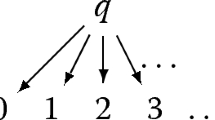Abstract
In this short essay, we describe in informal terms how game semantics can be seen to arise as a perturbation of process calculi such as CSP, by making an explicit distinction between the rôles of the System and the Environment. Drawing out the consequences of this distinction uncovers a wealth of mathematical structure, with Game intuitions entering in a natural and compelling fashion. This leads ultimately to the elaboration of mathematically well-structured and behaviourally expressive semantic universes for computation. These provide a basis for fully abstract models of a wide range of programming languages, and lead on to algorithmic methods, with applications to compositional model-checking and program analysis.
Similar content being viewed by others
Notes
- 1.
- 2.
These calculi do have notions of “deterministic” and “confluent” process as part of their theory [27, 32], but these notions refer to the absence of non-observable branching in the system. They do not directly correspond to the sense in which the computation of a standard functional or imperative program is deterministic.
- 3.
It is also easy to show that if Nigel and Gary are both playing winning strategies, meaning that they always have a response to the Environment’s actions, and that the infinite plays which may arise from following these strategies satisfy some given liveness specifications, then the composed strategy will again be a winning strategy, with respect to a liveness specification defined compositionally in a natural fashion from the given ones. See [1] for details and a proof of this.
- 4.
A key quality of this form of game semantics, as compared to earlier work in the logical literature, such as the Game-Theoretical Semantics of Hintikka [17] and the Dialogical game semantics of Lorenzen and his school [26], is its syntax-independence and compositionality. Here compositionality refers, crucially, to the level of strategies as well as merely to the games.
References
Abramsky, S.: Semantics of interaction: an introduction to game semantics. In: Dybjer, P., Pitts, A. (eds.), Proceedings of the 1996 CLiCS Summer School, Isaac Newton Institute, pp. 1–31. Cambridge University Press (1997).
Abramsky, S., Jagadeesan, R., Malacaria, P.: Full abstraction for PCF. Inform. Comput. 163, 409–470 (2000).
Abramsky, S.: Algorithmic game semantics: a tutorial introduction. In: Proof System-Reliability. Kluwer (2002).
Abramsky, S.: What are the fundamental structures of concurrency?: We still don’t know! Electr. Notes Theor. Comput. Sci. (ENTCS) 162, 37–41 (2006).
Abramsky, S.: Temperley-Lieb algebra: from knot theory to logic and computation via quantum mechanics. In: Chen, G., Kauffman, L., Lomonaco, S., (eds.), Mathematics of Quantum Computation and Quantum Technology, Taylor & Francis. pp. 415–458 (2007).
Abramsky, S., Ghica, D.R., Murawski, A.S., Stark, I.D.B., Ong. C.-H.L.: Nominal games and full abstraction for the nu-calculus. In: Proceedings LICS 150–159 (2004).
Abramsky, S., Honda, K., McCusker, G.: A fully abstract game semantics for general references. In: Proceedings LiCS 334–344 (1998).
Abramsky, S., Jagadeesan, R.: Games and full completeness for multiplicative linear logic. J. Symbolic Logic 59, 543–574 (1994).
Abramsky, S., McCusker, G.: Linearity, sharing and state. In: O’Hearn, P., Tennent, R.D. (eds.) Algol-Like Languages, pp. 317–348. Birkhauser (1997).
Abramsky, S., Mellies, P.-A.: Concurrent games and full completeness. In: Proceedings LiCS 431–442 (1999).
Danos, V., Harmer, R.: Probabilistic game semantics. ACM Trans. Comput. Log. 3(3), 359–382 (2002).
Blute, R., Hamano, M., Scott, P.J.: Softness of hypercoherences and MALL full completeness. Ann. Pure Appl. Logic 131(1–3), 1–63 (2005).
Devarajan, H., Hughes, D., Plotkin, G., Pratt, V.: Full completeness of the multiplicative linear logic of Chu spaces. In: Proceedings LiCS 234–242 (1999).
Ghica, D.R., McCusker, G.: Reasoning about idealized algol using regular languages. In: Proccedings ICALP’00, pp. 103–116 (2000). LNCS 1853.
Ghica, D.R., Murawski, A.S.: Angelic semantics of fine-grained concurrency. In: Proccedings FOSSACS’04, pp. 211–225 (2004). LNCS 2987.
Harmer, R., McCusker, G.: A fully abstract game semantics for finite nondeterminism. In: Proceedings LiCS (1999).
Hintikka, J., Sandu, G.: Game-theoretical semantics, in van Benthem and ter Meulen. Handbook of Logic and Language. Elsevier (1996).
Hoare, C.A.R.: Communicating Sequential Processes. Prentice Hall (1985).
Hyland, J.M.E., Ong, C.-H.L.: On full abstraction for PCF. Inform. Comput. 163, 285–408, (2000).
Landin, P.J.: The next 700 programming languages. Commun. ACM (CACM) 9(3), 157–166 (1966).
Laird, J.: Full abstraction for functional languages with control. Extended abstract. In: Proceedings LICS (1997).
Laird, J.: A fully abstract games semantics of local exceptions. Extended abstract. In: Proceedings LICS (2001).
Laird, J.: Game semantics for higher-order concurrency. In: Proceedings FSTTCS 2006, Springer LNCS Vol. 4337 pp. 417–428 (2006).
Legay, A., Murawski, A.S., Ouaknine, J., Worrell, J.: On automated verification of probabilistic programs. TACAS 173–187 (2008).
Loader, R.: Models of lambda calculi and linear logic. D.Phil. thesis, Oxford University (1994).
Lorenzen, P.: Ein dialogisches Konstruktivitätskriterium. In: Infinitistic Methods, 193–200 (1961).
Milner, R.: Communication and Concurrency. Prentice Hall (1989).
Milner, R., Parrow, J., Walker, D.: A calculus of mobile processes, I Inf. Comput. 100(1), 1–40 (1992).
Milner, R., Parrow, J., Walker, D.: A calculus of mobile processes, II Inf. Comput. 100(1), 41–77 (1992).
Milner, R.: Communicating and Mobile Systems: The Pi Calculus. Cambridge University Press (1999).
Parrow, J., Victor, B.: The Fusion Calculus: Expressiveness and Symmetry in Mobile Processes LICS 1998: 176–185.
Roscoe, A.W.: The Theory and Practice of Concurrency. Prentice Hall (1997).
Tzevelekos, N.: Full abstraction for nominal general references. In: Proceedings LICS pp. 399–410 (2007).
Acknowledgements
My thanks to Bill Roscoe and Paul Levy for their comments on an earlier version of this paper, which led to several clarifications. The remaining obscurities and inaccuracies are entirely my responsibility.
Author information
Authors and Affiliations
Corresponding author
Editor information
Editors and Affiliations
Rights and permissions
Copyright information
© 2010 Springer London
About this chapter
Cite this chapter
Abramsky, S. (2010). From CSP to Game Semantics. In: Roscoe, A., Jones, C., Wood, K. (eds) Reflections on the Work of C.A.R. Hoare. Springer, London. https://doi.org/10.1007/978-1-84882-912-1_2
Download citation
DOI: https://doi.org/10.1007/978-1-84882-912-1_2
Published:
Publisher Name: Springer, London
Print ISBN: 978-1-84882-911-4
Online ISBN: 978-1-84882-912-1
eBook Packages: Computer ScienceComputer Science (R0)




